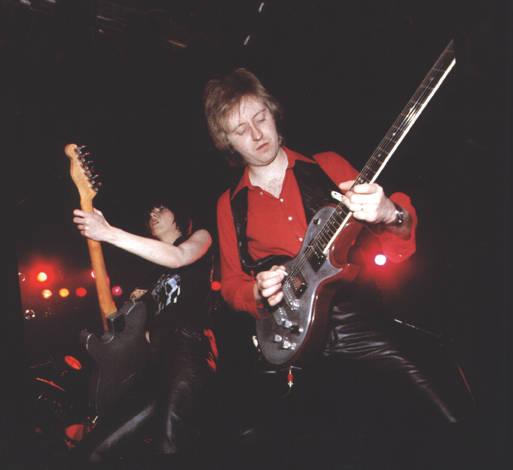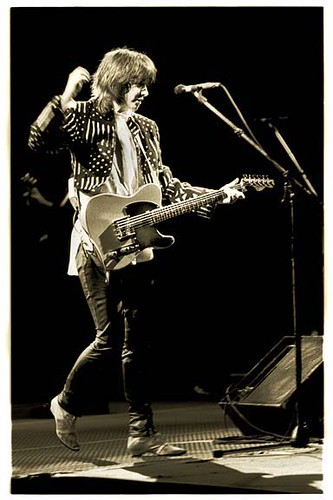Don’t feel sorry for music-magazine “editors”.
Oh, sure, they have to keep up with the latest trends and whatnot. And that, to be sure, is a gruelling job. It takes a huge nasal sinus cavity to even hold all the cocaine that it takes to get to the bottom of that kind of story.
But every five years or so, they can kick back and relax for at least one issue – because that’s the turnaround cycle for the obligatory “WOMEN WHO ROCK” issue of whatever it is they’re doing. In it, accompanied by cheesecake-via-the-“gritty”-filter photos of the “women who rock” in question, we are solemnly informed that the walls of the hitherto-all-male, mysogynistic, testosterone-guzzling world of Rawk ‘n Rawl have been breached by a new pack of ladies who, lest we doubted it, do it all on their own terms.
Over the past thirty years, we’ve been visited with the notion that The Runaways, Suzi Quattro, Joan Jett, Cindy Lawson, Kat Bjelland and Lori Barbero, Lita Ford, Courtney Love, Liz Phair, Jennifer Trynin, Avril Lavigne, Alanis Morisette, and any number of women in between (as well as any number of slightly poppier varieties – Katrina Leskanich, the Bangles, the Triplets – and dancier, style-bending ones like Madonna and Gwen Stefani) have imprinted their stilettos on the face of Rawk and Rowl, combining millenia of inborn feminist wisdom with hooks you can hang Stiv Bators’ man-tackle on (plus they’re babes to boot!)
Note to all music critics and “editors”: Stop. It has all been done.
Thirty years ago today, in fact; January 19, 1980; the date The Pretenders was released.

And there has never been, and never will be, a woman in rock and roll who can hold a Telecaster to Chrissy Hynde.
And since then, really, the whole “women who rawk the boyz club!” story has been utterly obsolete.
It’s hard to describe the impact that The Pretenders had on music at the time. I remember the first time I heard the record, on the turntable at Mother’s Records in Jamestown, as clearly now as the day it happened; the initial suspended-fourth chord wash that kicks off “The Wait“, the most distinctive, succinct-but-glorious intro since “A Hard Day’s Night”, ending in…

…that grunt. “Huuunnnnnh!”. Snotty, loud – and sexier than anything the 16 year old Mitch Berg had ever heard on record.
But women – and riot grrls – had done “sexy” before; if Otter Tail Power could have attached electric leads to the crowd of ninth-grade boys gathered in front of Mother’s Records in Jamestown when The Runaways’ first poster went up in the window, they could have jump-started every stalled car in town through that cold January.
Of course, there was so much more to The Pretenders, and Pretenders, than Hynde. Producer Chris Thomas, who’d worked with the Sex Pistols, and would go on to make INXS superstars using many of the same signatures, defined his style on this record – the bright, clear guitars, the percussion that dared you not to dance or slam or have sex or whatever grabbed you, the crisp, paradoxical clean-ness of an album that was a high point of a fundamentally grungy genre.
And of course, the band – in its original form, one of the tightest, most incendiary bands in the history of New Wave, Post-Punk or whatever the hell they were. Pete Farndon, the dark, leather-clad, greaser bass player…

…was a solid yet fluid technician who filled up immense space behind Hynde’s eccentric rhythm guitar style and the booming, aggressive, almost Keith-Moon-ish drumming of Martin Chambers…

…the gleefully “bloke”-y powerhouse drummer. Together, they were the most distinctive rhythm section of the whole genre.
And of course, James Honeyman-Scott, a spectacular, explosive guitarist in the Dave Davies mold…

…whose style – frenetic yet harmonically gorgeous, which could jump from strangled thrashing to chiming anthemic figures so fast it left me wondering “hunh?” – was, along with Mike Campbell, the biggest single influence on my guitar style at the time.
And of course, Hynde.

She snarled – but with a literate edge.

She oozed smart – in a way that had every teenage boy with a majoritarian libido walking doubled-over.
You just knew your mom would hate her, and you were dying to prove it. She oozed “sexy” in a way that was utterly unlike any of the other icons of the day, the Farrah Fawcetts and the like, did; she exuded an edge that went beyond confidence to a sort of muted menace – which made her all the sexier.
Together? They were like the second coming of the Kinks, (a band Hynde admired so much she married Ray Davies, in addition to covering “Stop Your Sobbing” on the debut) only harder, more intense. They were – Hynde’s domination notwithstanding – an ensemble; their parts interleaved with the sort of effortless grace and gleeful confidence that came from relentless practice to get that good. They were four musicians at the absolute peak of their craft.
There were really many sides on display on Pretenders; the ferocious, articulate post-punk of “Precious“,
“Tattooed Love Boys” a controversial, relentlessly un-PC 7/4-time sprint driven by Honeyman-Scott’s disjointed signature guitar figure, Hynde’s muffled, grinding rhythm guitar and a demented shuffle of a drum part.
“The Phone Call”, “Up the Neck” and, perhaps the best pop-punk song ever written, the frenetic-yet-glorious “The Wait”; the cool, shimmery brit-pop of “Kid”, and their debut single, “Brass in Pocket“; the slow departure “Lovers Of Today”, an almost R’nB-like ballad which presaged the group’s cover of “Thin Line Between Love And Hate” a few years later; the quirky, almost funky “Private Life”, which you can almost hear Prince covering; the hilariously off-beat Farndon/Honeyman-Scott instrumental “Space Invader” (yes, it was an homage to the video game); a very faithful cover of the early Kinks’ single “Stop Your Sobbing” which served as an audio mash note from Hynde to Ray Davies, one of her idols and, eventually, boyfriend…
…and, to me, the best of all – “Mystery Achievement “.
Clocking in at five minutes and change, and driven by a bass line that almost serves as a percussion track on its own, the song pays audible homage to Stax/Volt soul music, linking an almost-paranoid, minor-key verse with the most irresistable sing-along chorus of the genre. It features one of Honeyman-Scott’s most inflammable guitar solos, and impenetrable yet delectable background vocals, and sends the album off with a glimmering, unforgettable bang.
The album was a shooting star, a brash explosion of sound and sexuality and gritty-but-shimmering atmosphere, as explosive and ephemeral as any great moment coursing across the ether. It hit, it exploded, it kicked open doors that (whiny music editors notwithstanding) never really closed, even if those who came after could never fill the gap like Hynde at that moment, with those bandmates, at that time.
It was never the same after that, of course; Hynde – the undeniable boss – fired Farndon for his excessive drug use in ’82, as their long-delayed second album was nearing completion; Honeyman-Scott died of an overdose himself that same week at age 25. Farndon, shattered, died of an overdose himself less than a year later.
The Pretenders were never the same; they were never really a band again. They were the Chrissy Hynde show, with special guests. And they were amazing special guests, at times; Hynde’s tribute to her fallen bandmates, “Back On The Chain”, brought in Big Country’s Tony Butler on bass and Rockpile’s Billy Bremner on guitar; on Learning To Crawl, she enlisted crack session guitarist Robbie McIntosh and bass whiz Malcolm Foster; the Pretenders later included the likes of Johnny Marr, Andy Rourke and Bernie Worrell.
Which, of course, undercuts the entire “Women Who RAWK!” conceit; the Pretenders weren’t great because of Chrissie Hynde’s chromosomes; they were great because, for a two year stretch thirty years ago, four great, theretofore-unknown musicians got together and did something much greater than the sum of its parts. Which doesn’t sell magazines quite like “Women Who RAWK” does, I guess.
That’s not to say that Hynde didn’t go on to write and record a lot of great music. But nothing topped Pretenders.
Of course, after that there was nothing to prove.


Of course, after that there was nothing to prove.
Damn right. Got the album in 1980 and I haven’t stopped listening to it yet. Still sounds as fresh as it did the day it came out. Great tribute, Mitch.
Great read, super job Mitch. THANKS!
Fantastic! Spot on. I have to add that the re-issues for PI/PII that Rhino put out a few years ago were reviewed by Q magazine and got only 3 stars. I thought that this must be some sort of joke. Popmatters on the other hand, got it right! See link below.
http://www.popmatters.com/pm/review/the-pretenders-pretenders/
“Many sides” – I remember trying to get my then girlfriend in 1980 to love this record as much as I did, (she was not a musician) because I experienced it in the same way – This was really the second shot across the bow for me, the first being hearing the needle drop on “Never Mind The Bollocks” a couple of years earlier in a little headshop/record store in SD – But the Pretenders were, taking notice as well as I did I assume, more literate and more polished – You really did need to hear them in chronological context to understand how unique they were at the time –
Thanks for the post Mitch –
Pingback: Enough with the Women Who Rawk! — Secrets of the City — Minneapolis + St. Paul
I don’t get the bass out much these days, but, every now and then, when the need to plug in, turn up the volume, and jam kicks in, Farndon’s lines are always a part of the mix.
Thanks for giving the man his due: he pretty much was a one-man rhythm section. “Mystery Achievement” – classic example of restraint in movement. All forward motion.
Wonderful stuff.
Um, two words for ya, Mitch: Patti Smith